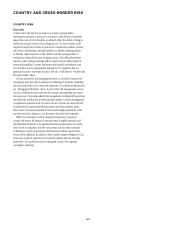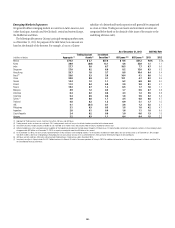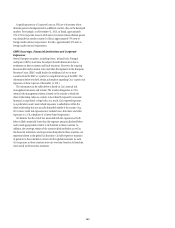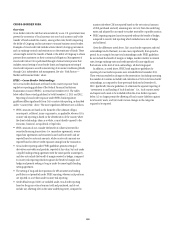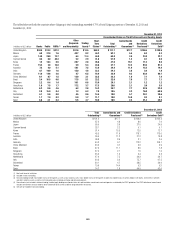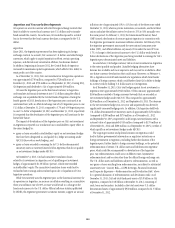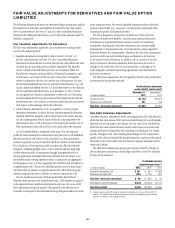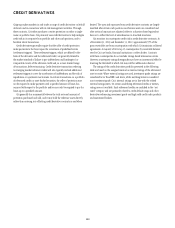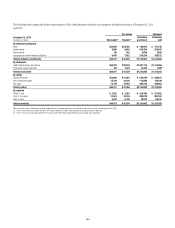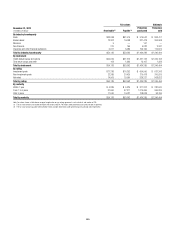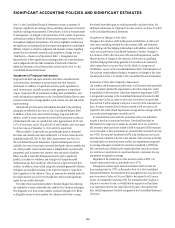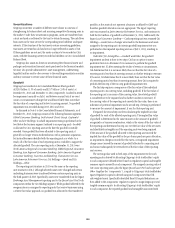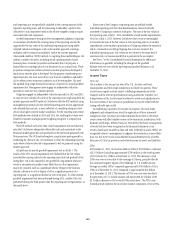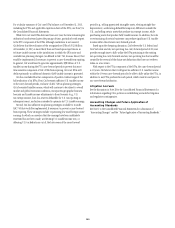Citibank 2013 Annual Report Download - page 148
Download and view the complete annual report
Please find page 148 of the 2013 Citibank annual report below. You can navigate through the pages in the report by either clicking on the pages listed below, or by using the keyword search tool below to find specific information within the annual report.130
Argentina and Venezuela Developments
Citi operates in several countries with strict foreign exchange controls that
limititsabilitytoconvertlocalcurrencyintoU.S.dollarsand/ortransfer
funds outside the country. In such cases, Citi could be exposed to a risk of
lossintheeventthatthelocalcurrencydevaluesascomparedtotheU.S.
dollar.
Argentina
Since2011,theArgentinegovernmenthasbeentighteningitsforeign
exchangecontrols.Asaresult,Citi’saccesstoU.S.dollarsandotherforeign
currencies, which apply to capital repatriation efforts, certain operating
expenses, and discretionary investments offshore, has become limited.
In addition, beginning in January 2012, the Central Bank of Argentina
increased its minimum capital requirements, which affects Citi’s ability to
remit profits out of the country.
As of December 31, 2013, Citi’s net investment in its Argentine operations
was approximately $730 million, compared to $720 million as of
December31,2012and$750millionasofSeptember30,2013.During2013,
Citi Argentina paid dividends to Citi of approximately $90 million.
Citi uses the Argentine peso as the functional currency in Argentina
andtranslatesitsfinancialstatementsintoU.S.dollarsusingtheofficial
exchange rate as published by the Central Bank of Argentina. During the
fourth quarter of 2013, devaluation of the Argentine peso continued at an
accelerated rate, with an official exchange rate of 6.52 Argentine pesos to one
U.S.dollaratDecember31,2013,comparedto5.79and4.90Argentinepesos
tooneU.S.dollaratSeptember30,2013andDecember31,2012,respectively.
It is expected that the devaluation of the Argentine peso will continue for the
foreseeable future.
The impact of devaluations of the Argentine peso on Citi’s net investment
in Argentina is reported as a translation loss in stockholders’ equity offset, to
the extent hedged, by:
• gainsorlossesrecordedinstockholders’equityonnetinvestmenthedges
that have been designated as, and qualify for, hedge accounting under
ASC815Derivatives and Hedging; and
• gainsorlossesrecordedinearningsforitsU.S.-dollar-denominated
monetary assets or currency futures held in Argentina that do not qualify
asnetinvestmenthedgesunderASC815.
At December 31, 2013, Citi had cumulative translation losses
related to its investment in Argentina, net of qualifying net investment
hedges, of approximately $1.30 billion (pretax), which were recorded
in stockholders’ equity. The cumulative translation losses would not be
reclassified into earnings unless realized upon sale or liquidation of Citi’s
Argentine operations.
While Citi currently uses the Argentine peso as the functional currency for
its operations in Argentina, an increase in inflation resulting in a cumulative
three-year inflation rate of 100% or more would result in a change in the
functionalcurrencytotheU.S.dollar.Officialinflationstatisticspublished
by INDEC, the Argentine government’s statistics institute, suggest an annual
inflation rate of approximately 10% to 11% for each of the three years ended
December 31, 2013, whereas private institutions, economists, and local labor
unions calculate the inflation rate to be closer to 25% to 30% annually over
the same period. On February 1, 2013, the International Monetary Fund
(IMF) issued a declaration of censure against Argentina in connection with
the Argentine government’s inaccurate inflation statistics. In February 2014,
the Argentine government announced the new national consumer price
index (CPI), and official inflation in January 2014 under the new CPI was
3.7%.AchangeinthefunctionalcurrencytotheU.S.dollarwouldresultin
future devaluations of the Argentine peso being recorded in earnings for Citi’s
Argentine peso-denominated assets and liabilities.
As noted above, Citi hedges currency risk in its net investment in Argentina
totheextentpossibleandprudent.Suitablehedgingalternativeshave
become less available and more expensive and may not be available to offset
any future currency devaluations that could occur. Moreover, on February 4,
2014, Argentina’s central bank enacted new regulations which limit banks’
holdings of foreign currency, which could further limit Citi’s ability to hedge
itscurrencyriskbyholdingU.S.dollarassetsinCitiArgentina.
As of December 31, 2013, Citi’s total hedges against its net investment in
Argentina were approximately $940 million. Of this amount, approximately
$160 million consisted of foreign currency forwards that are recorded as
netinvestmenthedgesunderASC815.Thiscomparedtoapproximately
$200millionasofDecember31,2012andSeptember30,2013.Thedecrease
in the net investment hedge year-over-year and sequentially was driven by
significantly increased hedging costs. In addition, Citi Argentina held both
U.S.-dollar-denominatednetmonetaryassetsofapproximately$470million
(compared to $280 million and $370 million as of December 31, 2012
andSeptember30,2013,respectively)andforeigncurrencyfutureswitha
notional value of approximately $310 million (compared to $170 million as
ofDecember31,2012and$200millionasofSeptember30,2013),neitherof
whichqualifyasnetinvestmenthedgesunderASC815.
The ongoing economic and political situation in Argentina could
lead to further governmental intervention or regulatory restrictions on
foreign investments in Argentina, including further devaluation of the
Argentine peso, further limits to foreign currency holdings, or the potential
redenominationofcertainU.S.dollarassetsandliabilitiesintoArgentine
pesos, which could be accompanied by a devaluation of the Argentine
peso. Any redenomination could occur at different rates (asymmetric
redenomination) and/or rates other than the official foreign exchange rate.
TheU.S.dollarassetsandliabilitiessubjecttoredenomination,aswellas
any gains or losses resulting from redenomination, are subject to substantial
uncertainty(see“CountryRisk—GIIPSSovereign,FinancialInstitution
and Corporate Exposures—Redenomination and Devaluation Risk” above
for a general discussion of redenomination and devaluation risk). As of
December 31, 2013, Citi had total third-party assets of $3.9 billion in Citi
Argentina, compared to $3.8 billion at December 31, 2012, consisting of
cash,loansandsecurities.IncludedinthetotalassetswereU.S.-dollar-
denominated assets of approximately $920 million, compared to $1.5 billion
at December 31, 2012.


